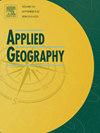Topographic change associated with floodplain mining activities in the Amite River, Louisiana
IF 4
2区 地球科学
Q1 GEOGRAPHY
引用次数: 0
Abstract
Human activities, including mining, have altered landscapes for millenia. A location showing appreciable anthropogenic change is the middle Amite River and floodplain in southeastern Louisiana. Because of regional demand for construction and lack of other aggregate resources, gravel and sand mining began in the 1930s and has generally increased over the past century. Countless geomorphological alterations have occurred, including the creation of pits and ponds of diverse sizes and shapes. In this paper, we employed numerical methods to analyze changes in mining topology within the Middle Amite floodplain. Specifically, we utilized the Level Set Method (LSM), a numerical approach developed by Osher and Sethian in 1998, to assess surface curvature and shape. Additionally, the Localized Contour Tree (LCT) was applied to delineate mining depressions. Using LiDAR DEMs from 2005 to 2018, in a floodplain area of 9.6 km2, the results indicate a marked increase in the number of pit depressions, rising from 163 to 289 and expanding of the depressions total area from 845.6 ha to 952.3 ha, with the most substantial growth observed in Reach D. , with notably, increase in the mean elevation ranges, particularly in Reach B, which saw depths grow from 1.3 m to 4.23 m. However, the volume storage showed an overall decline from ∼28.6 million m³ to ∼26.7 million m³, driven largely by a significant reduction in Reach E. The decrease in the storage capacities could be explained by the filling of the sedimentation of the pits over time, changes in the mining practices that may involve intentionally reducing pit volume capacity, other interactions within the floodplain environment such as pit captures contributing to the observed decrease in volume storage, or water level changes between the LiDAR imagery. implications of this study include the massive anthropogenic change in 13 years and decreases in floodplain water storage capacity, emphasizing the need for adaptive flood management strategies. These findings also provide practical guidance for environmental management and policy formulation, as the current state sand and gravel mining BMPs and buffer zones were inadequate to prevent pit captures the potential application of these methods elsewhere.
与路易斯安那州阿米特河漫滩采矿活动相关的地形变化
几千年来,包括采矿在内的人类活动已经改变了景观。显示明显人为变化的地点是路易斯安那州东南部的阿米特河中部和洪泛区。由于区域建筑需求和缺乏其他综合资源,砾石和砂石开采始于20世纪30年代,并在过去的一个世纪中普遍增加。无数的地貌变化发生了,包括各种大小和形状的坑和池塘的形成。本文采用数值方法分析了中阿米特漫滩内采矿拓扑结构的变化。具体来说,我们使用了水平集方法(LSM),这是Osher和Sethian在1998年开发的一种数值方法,用于评估表面曲率和形状。此外,应用局部轮廓树(LCT)对开采凹陷进行圈定。2005 - 2018年,在9.6 km2的洪泛区范围内,利用激光雷达dem,发现坑坑数量明显增加,从163个增加到289个,坑坑总面积从845.6 ha扩大到952.3 ha,其中d河段增长最为明显,平均高程范围明显增加,尤其是B河段,深度从1.3 m增加到4.23 m。然而,储存量总体上从~ 2860万m³下降到~ 2670万m³,主要是由于河段e的显著减少。储存量的减少可以解释为:随着时间的推移,坑的沉积物被填满,采矿实践的变化可能涉及有意减少坑的体积容量,洪泛平原环境中的其他相互作用,如坑捕获,导致了所观察到的体积存储的减少。或者激光雷达图像之间的水位变化。本研究的启示包括13年来大规模的人为变化和洪泛区蓄水量的减少,强调了适应性洪水管理策略的必要性。这些发现也为环境管理和政策制定提供了实际指导,因为目前的砂和砾石开采bmp和缓冲区不足以防止坑捕获,这些方法在其他地方的潜在应用。
本文章由计算机程序翻译,如有差异,请以英文原文为准。
求助全文
约1分钟内获得全文
求助全文
来源期刊

Applied Geography
GEOGRAPHY-
CiteScore
8.00
自引率
2.00%
发文量
134
期刊介绍:
Applied Geography is a journal devoted to the publication of research which utilizes geographic approaches (human, physical, nature-society and GIScience) to resolve human problems that have a spatial dimension. These problems may be related to the assessment, management and allocation of the world physical and/or human resources. The underlying rationale of the journal is that only through a clear understanding of the relevant societal, physical, and coupled natural-humans systems can we resolve such problems. Papers are invited on any theme involving the application of geographical theory and methodology in the resolution of human problems.
 求助内容:
求助内容: 应助结果提醒方式:
应助结果提醒方式:


